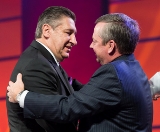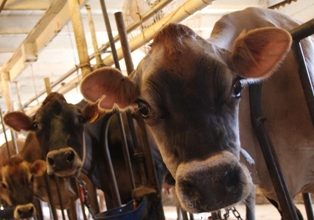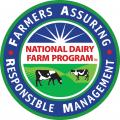 Dairy industry leaders from across the country converged on Phoenix for four days in mid-November to bid an emotional goodbye to outgoing NMPF President Jerry Kozak (left, with Mooney), and to hear incoming President Jim Mulhern’s vision for the organization’s future. The occasion was NMPF’s 2013 annual meeting, held jointly with the National Dairy Promotion and Research Board and the United Dairy Industry Association.
Dairy industry leaders from across the country converged on Phoenix for four days in mid-November to bid an emotional goodbye to outgoing NMPF President Jerry Kozak (left, with Mooney), and to hear incoming President Jim Mulhern’s vision for the organization’s future. The occasion was NMPF’s 2013 annual meeting, held jointly with the National Dairy Promotion and Research Board and the United Dairy Industry Association.
The meeting also featured a major policy speech by NMPF Board Chair Randy Mooney, and an expanded Town Hall in which 800 dairy farmers heard presentations on a long list of industry issues. In addition, six new board members were elected to the NMPF board, and the organization announced the name selected for the cartoon character it is using to help revitalize the dairy REAL® Seal.
 In all nearly 1,000 people attended the meeting at the Arizona Biltmore Hotel. Headline speakers were former NFL head coach Herman Edwards, and organizational change expert Peter Sheahan. Agri-Talk Radio host Mike Adams was master of ceremonies, and up-and-coming country music star James Wesley provided banquet entertainment. Wesley (left) clearly enjoyed performing for a large group of farmers.
In all nearly 1,000 people attended the meeting at the Arizona Biltmore Hotel. Headline speakers were former NFL head coach Herman Edwards, and organizational change expert Peter Sheahan. Agri-Talk Radio host Mike Adams was master of ceremonies, and up-and-coming country music star James Wesley provided banquet entertainment. Wesley (left) clearly enjoyed performing for a large group of farmers.
The meeting’s emotional highlight came when Kozak, president and CEO since 1997, thanked those with whom he has worked in the past 16 years, and turned the reins of the organization over to Mulhern.
Kozak will be formally replaced as president January 1 by current Chief Operating Officer Jim Mulhern, a Wisconsin native who has worked for the dairy industry in various capacities for three decades. During his remarks, Mulhern urged farmers to become more engaged in both NMPF and the policymaking process.
“We need your financial commitment, yes,” he said, “but even more importantly, we need your time and effort and engagement. The more engagement our members have … the more our organization can achieve for our members. It’s a virtuous circle.”
Mulhern also stressed the need for more communication by the dairy industry. “We must tell our story,” he said, “because if we don’t, others—who don’t have our interest at heart—are telling a very different, and harmful, story.”
 On other subjects, Mulhern (left) said once the 2013 farm bill is enacted, NMPF should tackle reform of the federal milk marketing order system and consider addressing some changes to federal identity standards for dairy foods—but only if the changes benefit farmers. “Some of the dairy processors talk about reforming federal milk orders when what they really seem to mean is increasing their control of the market and their share of the dairy dollar,” he said. “That’s a non-starter for us. Our focus will be on reforms needed to ensure the orderly marketing of milk and to protect the financial interests of the nation’s dairy farmers.”
On other subjects, Mulhern (left) said once the 2013 farm bill is enacted, NMPF should tackle reform of the federal milk marketing order system and consider addressing some changes to federal identity standards for dairy foods—but only if the changes benefit farmers. “Some of the dairy processors talk about reforming federal milk orders when what they really seem to mean is increasing their control of the market and their share of the dairy dollar,” he said. “That’s a non-starter for us. Our focus will be on reforms needed to ensure the orderly marketing of milk and to protect the financial interests of the nation’s dairy farmers.”
Mulhern noted that some in the processing community are also calling for changes to the federal standards that protect the content and quality of dairy foods. But, he said, sometimes this talk is delivered by those who either don’t understand the concept of standards of identity or those who are looking for a way to benefit financially through deviations marketed as “innovations.”
“Are there some provisions of standards that could be improved? Absolutely, especially if they relate to improvements and efficiencies in plant-level processing technologies,” Mulhern said. “However, NMPF will not agree to revisions to standards designed to ‘water down’ their quality or deceive consumers, and we will continue to work diligently to preserve all aspects of standards that preserve the integrity of traditional dairy products, their names and their composition.”
 Board chair Randy Mooney (left) delivered his speech as a House-Senate conference committee was working in Washington on a final, compromise version of the 2013 farm bill. Mooney blasted the House bill’s proposed dairy provisions as costly to taxpayers, a bonanza for processors and not what’s needed to help farmers.
Board chair Randy Mooney (left) delivered his speech as a House-Senate conference committee was working in Washington on a final, compromise version of the 2013 farm bill. Mooney blasted the House bill’s proposed dairy provisions as costly to taxpayers, a bonanza for processors and not what’s needed to help farmers.
Mooney said the House provisions would create conditions reminiscent of the early 1980s, when the federal dairy safety net was far too generous. In those days, he said, farmers produced more milk than the market could absorb and the government became their biggest customer.
Today, Mooney said, we are in danger of repeating history because some in Congress are forgetting the lessons of the past. “It’ll be cheap milk for processors, with taxpayers on the hook to keep the insurance money flowing,” he said. “And mark my words: If this approach were adopted, it would be the first, and last time, that a farm bill features this type of program. It’s just not built on a sound financial footing.”
The Town Hall, a tradition at NMPF annual meetings, kept attendees engaged throughout the four-hour session. Attendees heard presentations from NMPF staff on a long list of issues, which included the environment, trade, GMOs, food standards, and residue testing, in addition to the farm bill and immigration reform.
The following individuals were elected to serve as NMPF officers for 2014:
- Randy Mooney, Dairy Farmers of America – Chairman
- Ken Nobis, Michigan Milk Producers Association – First Vice Chairman
- Adrian Boer, Northwest Dairy Association – Second Vice Chairman
- Mike McCloskey, Select Milk Producers, Inc. – Third Vice Chairman
- Dave Fuhrmann, Foremost Farms USA – Secretary
- Doug Nuttelman, Dairy Farmers of America – Assistant Secretary
- Pete Kappelman, Land O’Lakes, Inc. – Treasurer
- Neal Rea, Agri-Mark – Assistant Treasurer (who is new to the officer group)
The following new board members were elected to serve on the NMPF board for 2014:
- Michael Anderson, Farmers Cooperative Creamery
- David Cooper, FarmFirst Dairy Cooperative
- Kelly King, FarmFirst Dairy Cooperative
- Peter Janzen, Land O’Lakes, Inc.
- Tom Pittman, Premier Milk, Inc.
Also at the meeting, NMPF unveiled the new name for the animated REAL® Seal character: DairyUS. It was selected in a nationwide online content in which nearly 800 votes were cast. DairyUS received 379 votes.
The animated character, based on the iconic REAL® Seal logo, will help a new generation of consumers distinguish between genuine U.S. dairy products and a growing list of list of imitations. A video announcing the name is on the REAL® Seal website homepage.
Also at the annual meeting, NMPF offered a preview of the REAL® Seal buyer’s guide, a web-based search engine that will make it easier for consumers to patronize brands and stores that offer real dairy products. The buyer’s guide website will soon be online.
More information from the annual meeting is available online, including speeches and presentations, and photos.

 Brenda Rowe (left) recently joined NMPF as Executive Assistant to the President & CEO. As Executive Assistant, she will support NMPF by managing activities related to the President’s office.
Brenda Rowe (left) recently joined NMPF as Executive Assistant to the President & CEO. As Executive Assistant, she will support NMPF by managing activities related to the President’s office. ARLINGTON, VA – A
ARLINGTON, VA – A 





